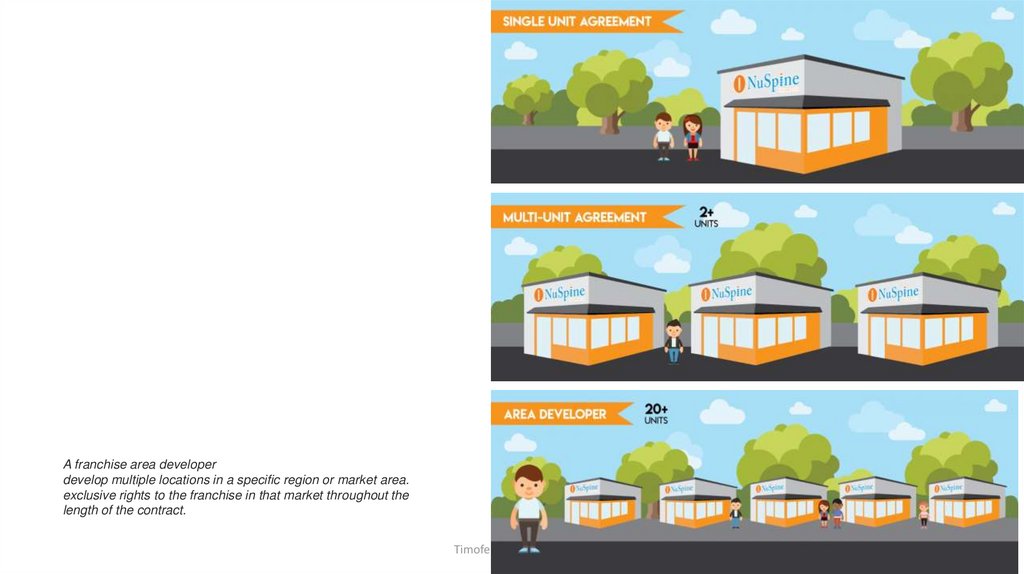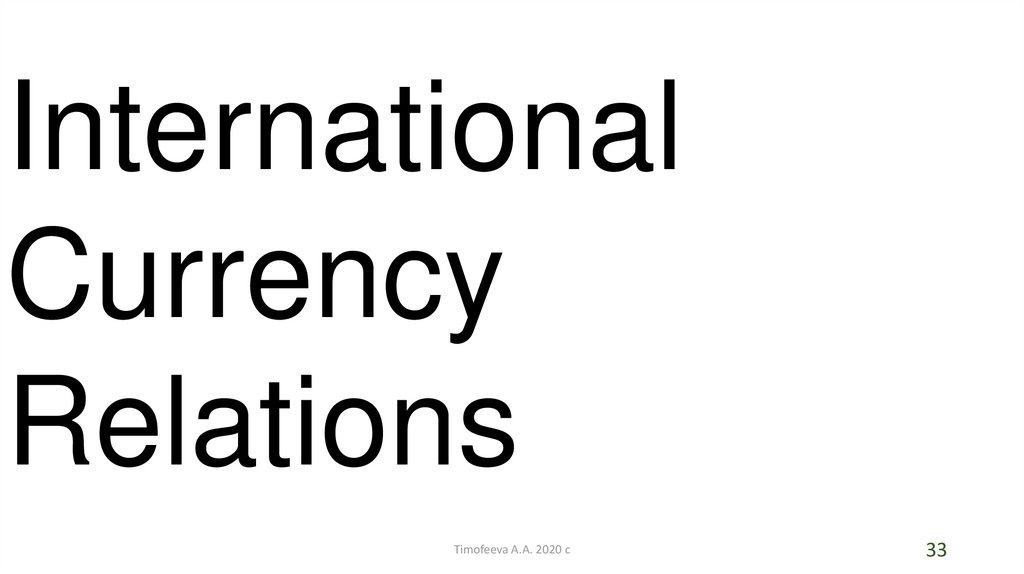Similar presentations:
International economic relations indicators
1.
Timofeeva A.A. 2020 c1
2.
Our previous lecture :Timofeeva A.A. 2020 c
2
3.
Timofeeva A.A. 2020 c3
4.
Our todays lecture :International
Exchange of
knowledge
Timofeeva A.A. 2020 c
4
5.
The forms of international economic relationsInternational trade in goods and services;
The international movement of capital;
Labour migration;
International exchange of knowledge;
The international currency and settlement relations.
Timofeeva A.A. 2020 c
5
6.
Timofeeva A.A. 2020 c6
7.
Nonprofit formsInternational exchange of knowledge
• scientific and technical publications;
• carrying out of exhibitions, fairs,
symposiums;
• the exchange of delegations and meetings of
scientists and engineers;
• migration of professionals;
• training students and postgraduates;
• activities of international organizations on
cooperation in the field of science and
technology, etc.
Timofeeva A.A. 2020 c
7
8.
On commercial basesInternational exchange of knowledge
• transfer on the terms of license agreements (patents, know-how, registered trademarks,
industrial designs);
• supply of machines and different Industrial equipment;
• rendering of technical assistance;
• export of equipment;
• preparation and training of specialists;
• management contracts;
• scientific-technical and production cooperation,
etc.c
Timofeeva A.A. 2020
8
9.
Licensing gives a licensee certain rights or resources to manufactureand/or market a certain product in a host country
•Licensing is a business agreement involving two companies: one gives the
other special permissions, such as using patents or copyrights, in exchange for
payment.
•An international business licensing agreement involves two firms from different countries,
with the licensee receiving the rights or resources to manufacture in the foreign country.
Timofeeva A.A. 2020 c
9
10.
Timofeeva A.A. 2020 c11.
Examples•Suppose Company A, a manufacturer and seller of Baubles, was based in the US and wanted to
expand to the Chinese market with an international business license. They can enter the agreement
with a Chinese firm, allowing them to use their product patent and giving other resources, in return for
a payment. The Chinese firm can then manufacture and sell Baubles in China.
Timofeeva A.A. 2020 c
11
12.
The rights or resources may includepatents,
trademarks,
managerial skills,
technology,
and others
=> make possible for the licensee to manufacture and sell in the host country a similar
product to the one the licensor has already been producing and selling in the home country
without requiring the licensor to open a new operation overseas
Timofeeva A.A. 2020 c
12
13.
The licensor’s earningsone-time payments
royalty payments
usually calculated as a percentage of sales.
Timofeeva A.A. 2020 c
13
14.
BatmanThe Batman character has been licensed to many companies, such as Lego
Timofeeva A.A. 2020 c
14
15.
Licensing: flexible work agreementcan be customized to fit the needs and interests of both licensor and licensee
Advantages and reasons to use an international licensing for expanding internationally:
•Obtain extra income for technical know-how and services.
•Reach new markets not accessible by export from existing facilities.
•Quickly expand without much risk and large capital investment.
•Pave the way for future investments in the market.
•Retain established markets closed by trade restrictions.
•Political risk is minimized as the licensee is usually 100% locally owned.
Timofeeva A.A. 2020 c
15
16.
Disadvantages and reasons:•Lower income than in other entry modes
•Loss of control of the licensee manufacture and
marketing operations and practices leading to loss of
quality
•Risk of having the trademark and reputation ruined by a
incompetent partner
•The foreign partner also can become a competitor by
selling its production in places where the parental
company has a presence
Timofeeva A.A. 2020 c
16
17.
Timofeeva A.A. 2020 c17
18.
Timofeeva A.A. 2020 c18
19.
FranchisingSimilar to a licensing agreement
multinational firm grants rights on its
intangible property, like technology or a
brand name, to a foreign company for a
specified period of time and receives a
royalty in return.
The difference is that the franchiser
provides a bundle of services and products
to the franchisee.
For example, McDonald’s expands overseas through franchises. Each franchise pays McDonald’s a franchisee fee and a percentage
of its sales and is required to purchase certain products from the franchiser. In return, the franchisee gets access to all of McDonald’s
products, systems, services, and management expertise. Timofeeva A.A. 2020 c
19
20.
Timofeeva A.A. 2020 c20
21.
Timofeeva A.A. 2020 c21
22.
Timofeeva A.A. 2020 c22
23.
Multi-Unit Franchisesthe franchisee owns and runs several outlets in a large geographical area
both the initial and ongoing costs will be much higher than for a single-unit franchise
control of all the customers in the territory in the long run, maximising profit potential.
Timofeeva A.A. 2020 c
23
24.
Key Terms for Multi-Unit FranchisesArea development agreement – With this type of agreement, the franchisor asks the franchisee to set up a
minimum number of units within a specified time period. This approach is favoured by franchisors who want
to expand their business as rapidly and efficiently as possible.
Sequential agreement – Here, the franchisee has more control over how many units they open because
the franchisor agrees to let the franchisee open new units when they have the funds to do so. Franchisors
can establish an opening timetable to suggest timings for new units, so franchisees should ensure that they
speak up if they feel it is too demanding to achieve.
Cross-default clause – This is a clause that is included in some franchise agreements. It states that if one
of the franchisee’s units fails, they have defaulted on their agreement obligations and so the franchisor can
buy back all of the franchisee’s units at a ‘depreciated value’ – even if they are still profitable. Franchisees
should challenge this clause if they find it in their agreement; if they agree to it, their whole network of
franchises could be destroyed by a single mistake outside of their control.
Timofeeva A.A. 2020 c
24
25.
A franchise area developerdevelop multiple locations in a specific region or market area.
exclusive rights to the franchise in that market throughout the
length of the contract.
Timofeeva A.A. 2020 c
25
26.
More Are Better: MultiBrand FranchisingContinues To Grow
two brands, three brands, more. When it comes to
growth and expansion, that's exactly what many
multi-unit operators have in mind. While some are
content--and quite successful--operating many units
of a single brand, others like to play ball with many
different brands, even different sectors.
With the right people and infrastructure in place,
multi-brand growth is a lucrative way to grow a
franchise organization--providing power in numbers,
the additional security of spreading risk across
several concepts, and cross-pollination of best
practices from each system.
Timofeeva A.A. 2020 c
26
27.
Timofeeva A.A. 2020 c27
28.
Timofeeva A.A. 2020 c28
29.
Timofeeva A.A. 2020 c29
30.
Timofeeva A.A. 2020 c30
31.
Timofeeva A.A. 2020 c31
32.
The forms of international economic relationsInternational trade in goods and services;
The international movement of capital;
Labour migration;
International exchange of knowledge;
The international currency and settlement relations.
Timofeeva A.A. 2020 c
32
33.
InternationalCurrency
Relations
Timofeeva A.A. 2020 c
33
34.
The international currency and settlement relationsis a set of economic relations arising at functioning of money in
international circulation.
Components:
1) means of payment (national
currency, gold, international
payment unit SDR and the
Euro;
2) the
mechanism
of
establishment
and
maintenance of exchange
rates;
3) the procedure for balancing
international payments.
4) international organizations
and complex international
Treaty and state law.
Timofeeva A.A. 2020 c
34
35.
International monetary relations:transactions of two or more countries
the main element - currency
The government of any country independently decides what form of interaction with foreign states to choose
most important element - currency
partially convertible;
freely convertible;
inconvertible.
there are about 160 currencies, 25 - convertible
Timofeeva A.A. 2020 c
35
36.
What is Forex (FX)?Forex (FX) is the marketplace where various national currencies are traded
The forex market is the largest, most liquid market in the world, with trillions of dollars changing hands every day.
There is no centralized location, rather the forex market is an electronic network of banks, brokers, institutions, and
individual traders (mostly trading through brokers or banks).
Timofeeva A.A. 2020 c
36
37.
Retail traders can open a forex account and thenbuy and sell currencies. A profit or loss results
from the difference in price the currency pair was
bought and sold at.
is a network of institutions
Retail traders typically don't want to have to
deliver the full amount of currency they are
trading. Instead, they want to profit on price
differences in currencies over time. Because of
this, brokers rollover positions each day.
Timofeeva A.A. 2020 c
37
38.
How Large Is the Forex?As an example, trading in foreign exchange markets averaged $6.6 trillion per day in April 2019
The largest foreign
exchange markets are
located in major global
financial centers like
London, New York,
Singapore, Tokyo,
Frankfurt, Hong Kong, and
Sydney.
Timofeeva A.A. 2020 c
38
39.
Timofeeva A.A. 2020 c39
40.
Timofeeva A.A. 2020 c40








































 economics
economics








